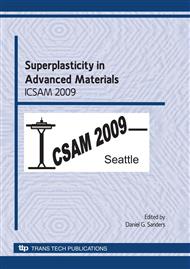[1]
D.G. Sanders : Mat. Sci. Forum, 304-306, 805-812, (1999).
Google Scholar
[2]
N. Chandra : Mat. Sci. Forum, 243-245, 643-652. (1997).
Google Scholar
[3]
P. Barnet, J-Y Moraux : EuroSPF08, France (2008) [hal-00371031 − version 1].
Google Scholar
[4]
P. Lours, S. Baleix, G. Bernhart : THERMEC 2000, 4-8 dec, 2000, Las Vegas, USA.
Google Scholar
[5]
A. Martinier : PdD thesis, (2006), Mines Nationale Supérieure des Mines de Paris.
Google Scholar
[6]
P. Lours, T. Cutard, G. Bernhart, C. Levaillant : Int. Journal of Materials and Products and Technology, SPM1, 2, (2001), 445.
Google Scholar
[7]
S. Baleix, P. Lours, G. Bernhart : in proceedings of the 8th International Conference on Mechanical Behaviours of Materials. Victoria (Canada) Vol 2, 653-657, (1999).
Google Scholar
[8]
G. Bernhart, A. Martinier, V. Velay and J-Y Moraux : ICSAM 2009 Conference, 30 june -02 july 2009, Seattle.
Google Scholar
[9]
A.A. Deshpande, S.B. Leen, T.H. Hyde.: in EuroSPF 2008, France (2008) [hal00337989 − version 1].
Google Scholar
[10]
S. Baleix, G. Bernhart, P. Lours : Materials Science and Engineering A, Vol 372, n°2, (2002), pp.155-166.
Google Scholar
[11]
S. Baleix, S. Le Roux, G. Bernhart, P. Lours : Journal of Material Processing Technology, Vol 118/1-3, (2001), pp.322-329.
Google Scholar
[12]
V. Velay, T. Cutard, N. Guegan: EuroSPF08, France (2008) [hal-00348613 − version 1].
Google Scholar
[13]
C.Y. Gao, P. Lours, G. Bernhart : International Journal of Processing Technology, vol 169, (2005) pp.281-291.
Google Scholar
[14]
J., Shang, T.H. Hyde, S.B. Leen : Journal of Strain Analysis, vol 41, no 8, 2006, pp.539-559.
Google Scholar
[15]
T. Branza, F. Deshaux-Beaume, V. Velay, P. Lours : Journal of materials Processing Technology, Vol 209, N° 2, (2009).
Google Scholar
[10]
sε − − =& , 50% Nickel) Fig. 5 : Rupture stress with respect to Ni content and temperature (columnar zone.
Google Scholar
[10]
sε − − =& ) Fig. 6: Stress-strain fatigue loops for increasing temperature.
Google Scholar
[10]
sε − − =& ) Fig. 7: Strains at the grain size level (Digital Image Correlation on carbides) Fig. 8: Local strain versus extensometer strain 500°C 650°C 750°C 800°C 850°C 900°C 950°C Strain (mm/mm) Stress (MPa) 500°C 650°C 750°C 800°C 850°C 900°C 950°C Strain (mm/mm) Stress (MPa).
DOI: 10.31857/s0869-5903275503-524-13797
Google Scholar
[50] 100 150 200 250 300 0, 00 0, 01 0, 02 0, 03 0, 04 0, 05 0, 06 Strain (mm/mm) Stress (MPa) 20°C 500° C 750°C 850°C 900°C 950°C.
Google Scholar
[50] 100 150 200 250 300 350 400 450 500.
Google Scholar
[20]
°C 500 °C 750 °C 850 °C 900 °C 950 °C R m (MPa).
Google Scholar
[25]
% /i 0, 5 % /i.
Google Scholar
[50] 100 150 200 250 300 350 400 450 500.
Google Scholar
[20]
°C 500 °C 750 °C 850 °C 900 °C 950 °C R m (MPa)R m (MPa).
Google Scholar
[25]
% /i 0, 5 % /i.
Google Scholar
[25]
% /i 0, 5 % /i.
Google Scholar
[1]
[2] [3] [4] [5] [6] [7] [8] [9] G M D.
Google Scholar
[1]
[2] [3] [4] [5] [6] [7] [8] [9] G M D.
Google Scholar
[1]
[2] [3] [4] [5] [6] [7] [8] [9] G M D.
Google Scholar
[16]
mm16 mm -20 -10.
Google Scholar
[10] [20] [30] [40] [50] [60] colonne gauche colonne milieu Ecart en % -20 -10.
Google Scholar
[10] [20] [30] [40] [50] [60] colonne gauche Ecart en %Difference in % Reference : modulus of elasticity given by mechanical extensometer -20 -10.
Google Scholar
[10] [20] [30] [40] [50] [60] colonne gauche colonne milieu Ecart en % -20 -10.
Google Scholar
[10] [20] [30] [40] [50] [60] colonne gauche Ecart en %Difference in % -20 -10.
Google Scholar
[10] [20] [30] [40] [50] [60] colonne gauche colonne milieu Ecart en % -20 -10.
Google Scholar
[10] [20] [30] [40] [50] [60] colonne gauche Ecart en %Difference in % Reference : modulus of elasticity given by mechanical extensometer Fig. 9 : Oxidation kinetics of 50% Ni HR Steel Fig. 10 : Spallation kinetic of 50% HR Steel Fig. 11 : Hollow die concept [3] Fig. 12 : Numerical simulation applied to die optimization.
Google Scholar
[1] [2] [3] [4] [5] [6] 0 100 200 300 400 500 600 700 Duration (h) 750 °C 800 °C 850 °C 900 °C 950 °C 1000 °C 1050 °C (∆∆∆∆m/S)ox(mg. cm-2).
Google Scholar
[1] [2] [3] [4] [5] [6] 0 100 200 300 400 500 600 700 Duration (h) 750 °C 800 °C 850 °C 900 °C 950 °C 1000 °C 1050 °C (∆∆∆∆m/S)ox(mg. cm-2) -0, 5.
Google Scholar
[1]
0 50 100 150 200 250 300 350 Duration (h) ∆∆∆∆m/S (mg. cm-2) Oxidation Kinetic Spalling Kinetic ti tc -0, 5.
Google Scholar
[1]
0 50 100 150 200 250 300 350 Duration (h) ∆∆∆∆m/S (mg. cm-2) Oxidation Kinetic Spalling Kinetic ti tc Free Convection (Cooling) Nodal temperature (Heating) Radiation: - Cooling (T∝ = 20°C); - Heating (T ∝ = 900°C) Cavity Radiation (Heating) Free Convection (Cooling) Radiation: - Cooling (T∝ = 20°C); - Heating (T ∝ = 900°C) Free Convection (Cooling) Nodal temperature (Heating) Radiation: - Cooling (T∝ = 20°C); - Heating (T ∝ = 900°C) Free Convection (Cooling) Nodal temperature (Heating) Free Convection (Cooling) Nodal temperature (Heating) Radiation: - Cooling (T∝ = 20°C); - Heating (T ∝ = 900°C) Cavity Radiation (Heating) Free Convection (Cooling) Radiation: - Cooling (T∝ = 20°C); - Heating (T ∝ = 900°C).
DOI: 10.3403/bsen14037
Google Scholar


